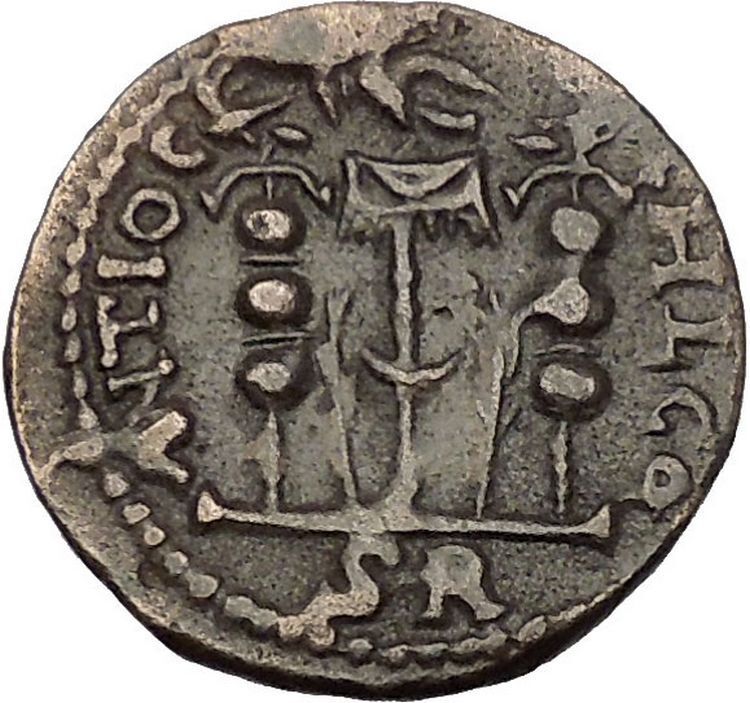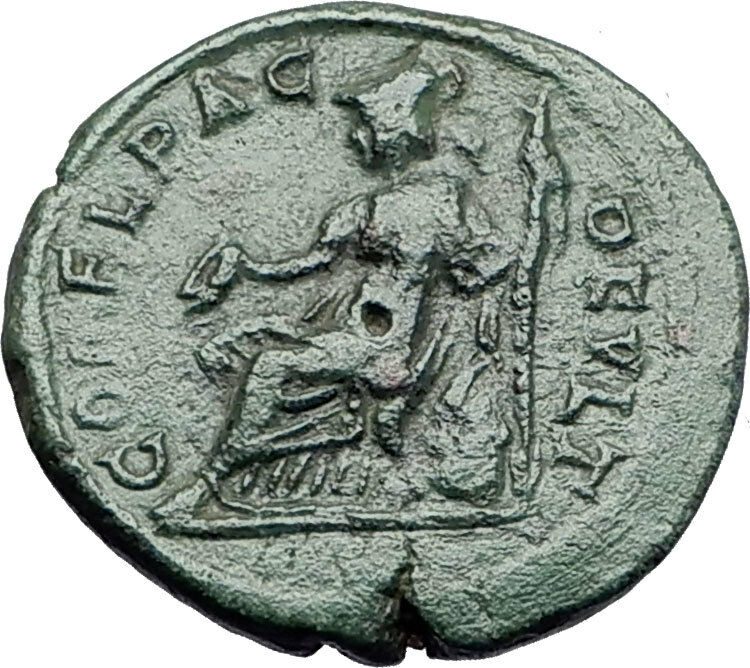|
Crispina – Roman Empress: 177-183 A.D.
Dramatic Sacrificial Scene
Bronze As 26mm (10.69 grams) of TROAS (TROY). Ilium.
Reference: RPC IV online 131. Bellinger T198-9.
KPICΠINA-CЄBACTH, draped bust of Crispina right, seen from front, hair braided and tucked in large chignon at base of head.
IΛ-IЄΩ-N, statue of Athena of Ilium right (on left), standing on short decorated column, wearing calathus, transverse spear in right hand, palladium in left, facing cow suspended left from tree (on right), with man grasping its horns and preparing to sacrifice it.
Through the Acta Arvalia, we know that a cow was sacrificed to Minerva on 13 October AD 58, to celebrate Nero’s coming to power. Later, cows were sacrificed to Minerva as part of New Year’s vows to protect the well-being of other emperors.
A city founded by the Aiolians in the seventh century B.C. on the site of ancient Troy, Ilion boasted a famous temple of Athena visited by both Xerxes and Alexander the Great. The city was honored by Alexander and, later, by the Romans who regarded Troy as their ancestral home.
You are bidding on the exact item pictured, provided with a Certificate of Authenticity and Lifetime Guarantee of Authenticity.
 Troy (Ancient Greek: Τροία, Troia or Τροίας, Troias and Ἴλιον, Ilion, Ilios; Troia and Ilium; Turkish: Truva or Troya) was a city in the far northwest of the region known in late Classical antiquity as Asia Minor, now known as Anatolia in modern Turkey, just south of the southwest mouth of the Dardanelles strait and northwest of Mount Ida. The present-day location is known as Hisarlik. It was the setting of the Trojan War described in the Greek Epic Cycle, in particular in the Iliad, one of the two epic poems attributed to Homer. Metrical evidence from the Iliad and the Odyssey suggests that the name Ἴλιον (Ilion) formerly began with a digamma: Ϝίλιον (Wilion); this is also supported by the Hittite name for what is thought to be the same city, Wilusa. Troy (Ancient Greek: Τροία, Troia or Τροίας, Troias and Ἴλιον, Ilion, Ilios; Troia and Ilium; Turkish: Truva or Troya) was a city in the far northwest of the region known in late Classical antiquity as Asia Minor, now known as Anatolia in modern Turkey, just south of the southwest mouth of the Dardanelles strait and northwest of Mount Ida. The present-day location is known as Hisarlik. It was the setting of the Trojan War described in the Greek Epic Cycle, in particular in the Iliad, one of the two epic poems attributed to Homer. Metrical evidence from the Iliad and the Odyssey suggests that the name Ἴλιον (Ilion) formerly began with a digamma: Ϝίλιον (Wilion); this is also supported by the Hittite name for what is thought to be the same city, Wilusa.
A new capital called Ilium (from Greek: Ἴλιον, Ilion) was founded on the site in the reign of the Roman Emperor Augustus. It flourished until the establishment of Constantinople, became a bishopric and declined gradually in the Byzantine era, but is now a Latin Catholic titular see.
In 1865, English archaeologist Frank Calvert excavated trial trenches in a field he had bought from a local farmer at Hisarlik, and in 1868, Heinrich Schliemann, a wealthy German businessman and archaeologist, also began excavating in the area after a chance meeting with Calvert in Çanakkale. These excavations revealed several cities built in succession. Schliemann was at first skeptical about the identification of Hisarlik with Troy, but was persuaded by Calvert and took over Calvert’s excavations on the eastern half of the Hisarlik site, which was on Calvert’s property. Troy VII has been identified with the city called Wilusa by the Hittites (the probable origin of the Greek Ἴλιον) and is generally (but not conclusively) identified with Homeric Troy.
Today, the hill at Hisarlik has given its name to a small village near the ruins, which supports the tourist trade visiting the Troia archaeological site. It lies within the province of Çanakkale, some 30 km south-west of the provincial capital, also called Çanakkale. The nearest village is Tevfikiye. The map here shows the adapted Scamander estuary with Ilium a little way inland across the Homeric plain. Due to Troy’s location near the Aegean Sea, the Sea of Marmara, and the Black Sea, it was a central hub for the military and trade.
 Crispina – Augusta: 177-182/3 A.D. Crispina – Augusta: 177-182/3 A.D.
| Wife of Commodus | Daughter-in-Law of Marcus Aurelius and Faustina Junior |
Bruttia Crispina (164-183 A.D.) was the Empress of Rome and wife of Roman Emperor Commodus.
Crispina’s mother is unknown and her father was twice consul Gaius Bruttius Praesens. Crispina’s paternal grandparents were consul and senator Caius Bruttius Praesens and rich heiress Laberia Hostilia Crispina, who was the daughter of another twice consul, Manius Laberius Maximus. Crispina’s brother was future consul Lucius Bruttius Quintius Crispinus. Her father’s family originally came from Volceii, Lucania, Italy and were closely associated with the Roman Emperors Trajan, Hadrian, Antoninus Pius and Marcus Aurelius. Crispina was born and raised in Rome or Volceii.
 Crispina married Commodus, in the summer of 178 (probably July). The actual ceremony was modest but it was commemorated on coinage and largesse was distributed to the people. An epithalamium for the occasion was composed by the sophist Julius Pollux. Like many marriages of young members of the upper orders, it was an arranged marriage: Crispina’s father and Marcus Aurelius (Commodus’ father) had arranged for it to occur. Commodus disliked Crispina, presumably due to her character – she was a beautiful woman, but said to be vain and haughty. She received the title of Augusta. Crispina married Commodus, in the summer of 178 (probably July). The actual ceremony was modest but it was commemorated on coinage and largesse was distributed to the people. An epithalamium for the occasion was composed by the sophist Julius Pollux. Like many marriages of young members of the upper orders, it was an arranged marriage: Crispina’s father and Marcus Aurelius (Commodus’ father) had arranged for it to occur. Commodus disliked Crispina, presumably due to her character – she was a beautiful woman, but said to be vain and haughty. She received the title of Augusta.
On the basis of a misreading of SHA Commodus 5.9 and Dio 73.4.6 her fall is sometimes wrongly associated with the conspiracy of Lucilla in 181 or 182. Her name continues to appear in inscriptions until as late as 191 (CIL 8.2366). Her eventual exile and death may instead have been associated with the fall of Marcus Aurelius Cleander or her inability to help Commodus ensure the dynastic succession.
Commodus – Roman Emperor: 177-192 A.D.
 Caesar: 166-177 A.D. (under Marcus Aurelius) | (166-169/170 A.D. with Annius Verus) | (169/170-177 Alone) | Caesar: 166-177 A.D. (under Marcus Aurelius) | (166-169/170 A.D. with Annius Verus) | (169/170-177 Alone) |
Augustus: 177-192 A.D. (177-180 A.D. with Marcus Aurelius) (180-192 A.D. Sole Reign)
Son of Marcus Aurelius and Faustina Junior | Husband of Crispina | Brother of Annius Verus, Lucilla and Aurelius Antoninus | Grandson of Antoninus Pius and Faustina Senior |
Commodus (Latin: Marcus Aurelius Commodus Antoninus Augustus; 31 August, 161 AD – 31 December, 192 AD), was Roman Emperor from 180 to 192. He also ruled as co-emperor with his father Marcus Aurelius from 177 until his father’s death in 180.
His accession as emperor was the first time a son had succeeded his father since Titus succeeded Vespasian in 79. He was also the first Emperor to have both a father and grandfather as the two preceding Emperors. Commodus was the first (and until 337 the only) emperor “born in the purple”; i.e. during his father’s reign.
Commodus was assassinated in 192.
|





 Troy (Ancient Greek: Τροία, Troia or Τροίας, Troias and Ἴλιον, Ilion, Ilios; Troia and Ilium; Turkish: Truva or Troya) was a city in the far northwest of the region known in late Classical antiquity as Asia Minor, now known as Anatolia in modern Turkey, just south of the southwest mouth of the Dardanelles strait and northwest of Mount Ida. The present-day location is known as Hisarlik. It was the setting of the Trojan War described in the Greek Epic Cycle, in particular in the Iliad, one of the two epic poems attributed to Homer. Metrical evidence from the Iliad and the Odyssey suggests that the name Ἴλιον (Ilion) formerly began with a digamma: Ϝίλιον (Wilion); this is also supported by the Hittite name for what is thought to be the same city, Wilusa.
Troy (Ancient Greek: Τροία, Troia or Τροίας, Troias and Ἴλιον, Ilion, Ilios; Troia and Ilium; Turkish: Truva or Troya) was a city in the far northwest of the region known in late Classical antiquity as Asia Minor, now known as Anatolia in modern Turkey, just south of the southwest mouth of the Dardanelles strait and northwest of Mount Ida. The present-day location is known as Hisarlik. It was the setting of the Trojan War described in the Greek Epic Cycle, in particular in the Iliad, one of the two epic poems attributed to Homer. Metrical evidence from the Iliad and the Odyssey suggests that the name Ἴλιον (Ilion) formerly began with a digamma: Ϝίλιον (Wilion); this is also supported by the Hittite name for what is thought to be the same city, Wilusa.  Crispina – Augusta: 177-182/3 A.D.
Crispina – Augusta: 177-182/3 A.D. Crispina married Commodus, in the summer of 178 (probably July). The actual ceremony was modest but it was commemorated on coinage and largesse was distributed to the people. An epithalamium for the occasion was composed by the sophist Julius Pollux. Like many marriages of young members of the upper orders, it was an arranged marriage: Crispina’s father and Marcus Aurelius (Commodus’ father) had arranged for it to occur. Commodus disliked Crispina, presumably due to her character – she was a beautiful woman, but said to be vain and haughty. She received the title of Augusta.
Crispina married Commodus, in the summer of 178 (probably July). The actual ceremony was modest but it was commemorated on coinage and largesse was distributed to the people. An epithalamium for the occasion was composed by the sophist Julius Pollux. Like many marriages of young members of the upper orders, it was an arranged marriage: Crispina’s father and Marcus Aurelius (Commodus’ father) had arranged for it to occur. Commodus disliked Crispina, presumably due to her character – she was a beautiful woman, but said to be vain and haughty. She received the title of Augusta. Caesar: 166-177 A.D. (under Marcus Aurelius) | (166-169/170 A.D. with Annius Verus) | (169/170-177 Alone) |
Caesar: 166-177 A.D. (under Marcus Aurelius) | (166-169/170 A.D. with Annius Verus) | (169/170-177 Alone) | 




